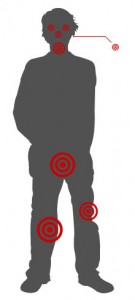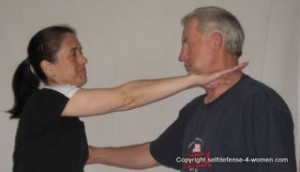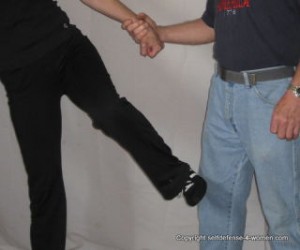Basic Self-Defense Moves Anyone Can Do
[fruitful_slider]
Would you be able to defend yourself and your loved ones if someone were to physically attack you? It’s a question most of us don’t want to consider, but violence is, unfortunately, a fact of life. Thankfully, regardless of strength, size, or previous training, anyone can learn several effective self-defense techniques. Here’s how to prepare for and stay safe in common real-world violent situations.
Prevention Is the Best Self-Defense
First, remember that prevention is the best self-defense. Attackers, whatever their objectives, are looking for unsuspecting, vulnerable targets. So be sure to follow general safety tips like being aware of your surroundings, only walking and parking in well-lit areas, keeping your keys in hand as you approach your door or car, varying your route and times of travel, and other personal security precautions.
Apart from avoiding confrontation, if you can defuse a situation (talk someone down from physically assaulting you) or get away—by handing over your wallet/purse or whatever they want, do that. Hand over your money rather than fight. Nothing you own is worth more than your life or health.
If violence is unavoidable, however, to really defend yourself, you’ll want to know ahead of time how to fight back effectively—it’s possible even against someone bigger or stronger than you. Here are some basic self-defense techniques that can keep you safe:
Get Loud and Push Back
As soon as the attacker touches you or it’s clear that escape isn’t possible, shout loudly (“BACK OFF!”) and push back at him or her (for simplicity’s sake we’re going to use “him” for the rest of the article, although your opponent could be female). This does two things: it signals for help and it lets the attacker know you’re not an easy target. The video at left from Rob Redenbach, a former trainer of Nelson Mandela’s bodyguards, shows why this is the first thing you need to do. It may not dissuade all attackers, but getting loud will warn off those that were looking for easy prey.
The Most Effective Body Parts to Hit
 When you’re in a confrontation, you only have a few seconds and a few moves to try before the fight may be decided. Before an attacker has gained full control of you, you must do everything you can—conserving as much energy as possible—to inflict injury so you can get away. (This is no time to be civil. In a physical confrontation that calls for self-defense, it’s hurt or be hurt.) So aim for the parts of the body where you can do the most damage easily: the eyes, nose, ears, neck, groin, knee, and legs.
When you’re in a confrontation, you only have a few seconds and a few moves to try before the fight may be decided. Before an attacker has gained full control of you, you must do everything you can—conserving as much energy as possible—to inflict injury so you can get away. (This is no time to be civil. In a physical confrontation that calls for self-defense, it’s hurt or be hurt.) So aim for the parts of the body where you can do the most damage easily: the eyes, nose, ears, neck, groin, knee, and legs.
Su Ericksen, who writes the very helpful Self-Defense for Women website, offers techniques for striking these pressure points so you can defend yourself and get to safety. She writes:
Depending on the position of the attacker and how close he is will determine where you will strike and with what part of your body you will employ. Do not step in closer, say, to strike his nose with your hand, when you can reach his knee with a kick.
When striking a target on the upper half of the body you will use your hand. Effective strikes can be made with the outer edge of your hand in a knife hand position, a palm strike or knuckle blow for softer targets or a tightly curled fist.
Here are some photos Su offers on attacking these highly sensitive pressure points (you can view others for additional pressure points on her website):
 Eyes: Gouging, poking, or scratching the attacker’s eyes with your fingers or knuckles would be effective, as you can imagine. Besides causing a lot of pain, this should also make your escape easier by at least temporarily interfering with his vision.
Eyes: Gouging, poking, or scratching the attacker’s eyes with your fingers or knuckles would be effective, as you can imagine. Besides causing a lot of pain, this should also make your escape easier by at least temporarily interfering with his vision.
 Nose: If the attacker is close in front of you, use the heel of your palm to strike up under his nose; throw the whole weight of your body into the move to cause the most pain and force him to loosen his grip on you. If he’s behind you, you can strike his nose (from the side or front) with your elbow. Either way, aim for the nasal bones.
Nose: If the attacker is close in front of you, use the heel of your palm to strike up under his nose; throw the whole weight of your body into the move to cause the most pain and force him to loosen his grip on you. If he’s behind you, you can strike his nose (from the side or front) with your elbow. Either way, aim for the nasal bones.
 Neck: The side of the neck is a bigger target, where both the carotid artery and jugular vein are located. You could possibly temporarily stun your attacker with a knife hand strike (all fingers held straight and tightly together, with thumb tucked and slightly bent at the knuckle) at the side of the neck. (For even more injury, you could thrust your elbow into your assailant’s throat while pitching the weight of your body forward. See the Target Focus Training video below.)
Neck: The side of the neck is a bigger target, where both the carotid artery and jugular vein are located. You could possibly temporarily stun your attacker with a knife hand strike (all fingers held straight and tightly together, with thumb tucked and slightly bent at the knuckle) at the side of the neck. (For even more injury, you could thrust your elbow into your assailant’s throat while pitching the weight of your body forward. See the Target Focus Training video below.)
 Knee: Su says the knee is an ideal self-defense target, vulnerable from every angle and easily kicked without risk of your foot being grabbed. Kick the side of the knee to cause injury or partially incapacitate your attacker. Kicking the front of the knee may cause more injury but is less likely to result in imbalance.
Knee: Su says the knee is an ideal self-defense target, vulnerable from every angle and easily kicked without risk of your foot being grabbed. Kick the side of the knee to cause injury or partially incapacitate your attacker. Kicking the front of the knee may cause more injury but is less likely to result in imbalance.
How to Maximize Damage
Use your elbows, knees, and head. Those are the parts of the body that are most sensitive when hit. Now here are the parts of the body used most effectively for inflicting damage: your elbows, knees, and head (they’re your body’s bony built-in weapons). This video from Elite Defense Systems in IL explains how to defend yourself against three most common attacks by using these key body parts.
Use everyday objects. Everyday objects you carry around with you or things in your environment can also be used to your advantage as weapons. Hold a key or pen between your middle and ring finger while you’re walking home in the dark for more assurance. Outdoors, you can toss some dirt or sand into your attacker’s eyes. Women are often told to spray perfume or hairspray into an assailant’s eyes. The point is, use what ever you can to make your defense stronger (for more inspiration, watch some Jackie Chan movies).
Leverage your weight. No matter your size, weight, or strength in relation to your opponent, you can defend yourself by strategically using your body and the simple law of physics. This is the principle behind martial arts systems like Jujitsu and other self-defense programs where a smaller person is able to defeat a larger one.
Tim Larkin teaches in his Target Focus Training self-defense system that striking is not about punching or kicking, it’s about throwing your body weight strategically at someone. You don’t want to be standing there trading punches or kicks with an attacker; in a violent situation, it’s critical to injure him using efficient, targeted moves. Basically, target those pressure points mentioned above, but leverage your weight to cause the most damage. (Note: The video at left is a bit long, though all of it is insightful; if you want to skip to the demonstration part showing how to use your body weight in this “point of injury” technique, scrub to about the 4-minute mark. Also note that this technique, used by law enforcement agencies, can seriously injure the attacker.)
Moves for Getting Out of or Defending Against Common Holds or Attacks
Wrist Hold: Gracie Jiu-Jitsu is another school of self-defense, one that offers modified Jujitsu techniques that normal (or even weak) people can carry out. This video from Gracie Academy shows what to do when an attacker has grabbed your wrist. Instead of pulling back to try to get out of the hold, squat down into a strong stance, then lean forward and bend your elbow towards him all the way towards his forearm until he can no longer hold onto your wrist.
Front and Back Choke Holds: Similarly, this video from Ford Models suggests bending your elbow in to get out of the wrist hold, but then pushing upwards to break free. The video also offers techniques to get out of a front choke hold and a back choke hold: Swing one arm across to break the attacker’s hold then use your other arm’s elbow or hand in a knife strike position to hit the attacker.
Bear Hug: Krav Maga is the official hand-to-hand self-defense system of the Israeli Defense Forces, with techniques to defend against realistic grabs and holds. This video shows a Krav Maga defense for when someone holds you from behind: Drop your weight and try to hit his head with your elbows or stomp his feet with your feet. If that doesn’t work, pull his fingers back to force him to release you, rotate out of his hold, and attack him with your knees/kicks. (Pulling fingers is also an effective move in a choke hold in some cases.)
Mount Position: If the attacker has you pinned on the floor, you can pivot to be on top with this Gracie Jiu-Jitsu technique. Hook onto his wrist with one hand and use your other hand to grab behind his elbow, trapping his arm to your chest. Then use your foot to trap his foot and leg, lift your hips and turn over onto your knees to get on top.
Sexual Assault: In my interview with Rener Gracie, whose grandfather established the Gracie Jiu-Jitsu method 90 years ago, he told me there are four phases to nearly all sexual attacks on women: 1) Identify an unsuspecting target, 2) Subdue the target, 3) Exhaust the target, and 4) Execute the sexual assault. We want to fight with all our might and the moves we have above in the second phase. In the third phase, however, right before an assailant executes his sexual attack, all he wants to do is exhaust the victim and gain complete control, so fighting back actually may backfire at that point, wasting energy. Gracie’s Women Empowered training program teaches women to recognize when they’ve entered that phase where they are truly trapped and are no longer in the defensive movements phase—and to feign giving in. Pretend to be compliant (kind of like playing dead for a bear). In those split moments, the predator will think you have given up and will loosen his grip, giving you a chance get away.
These are just a sampling of the kinds of self-defense moves and techniques that might protect you one day or at least help you feel safer and more confident. There’s no replacement, however, for taking a self-defense class and practicing the moves in real life.
To find a good self-defense program, the National Coalition Against Sexual Assault offers theseGuidelines for Choosing a Self-Defense Course.
You’ll probably easily find self-defense classes at martial arts centers, but other resources to look into include:
- Local colleges or community colleges
- Women’s centers
- Just Yell Fire—a free self-defense movie specifically for girls age 11-19
- C.O.B.R.A. Self-Defense classes—real world self-defense training
- Gracie Jiu-Jitsu Academy—online, DVD, and in-person self-defense training
If you know of any other good self-defense tips, techniques, or resources, please share them with us in the comments.
Su Ericksen is a first degree TaeKwonDo black belt and has taught self-defense workshops. She lives in the Midwest with her family and works at a large medical center in the cardiology clinic.
To read more about women’s self-defense, visit her web site: Self Defense-4-Women.com.
Established in 1925, The Gracie Jiu-Jitsu Academy is a global organization comprised of a network of Certified Training Centers. For more information Gracie Jiu-Jitsu, the Gracie Family, or any of their specialized self-defense programs, please visitwww.GracieUniversity.com.